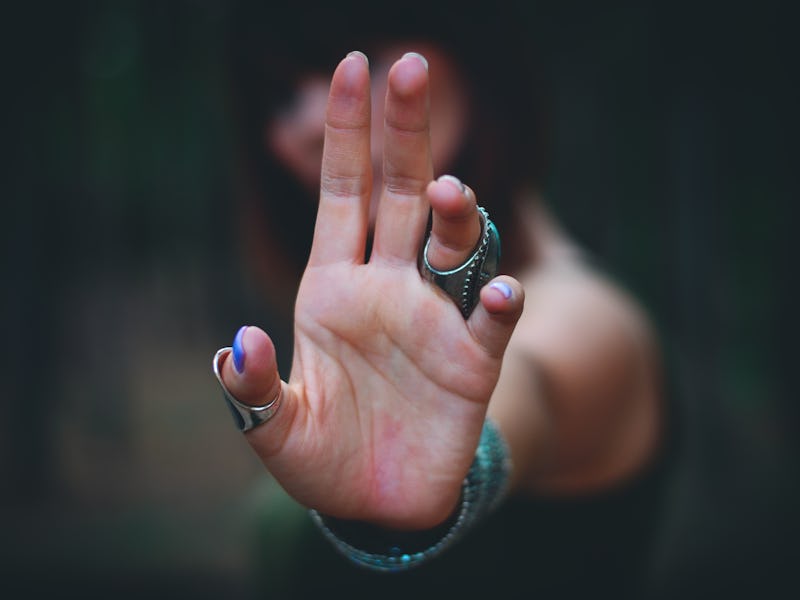Finger Length Is a Predictor of Female Sexual Orientation, Claim Scientists
"Research suggests that our sexuality is determined in the womb."

A person’s hands can say a lot about them, but the length of a woman’s fingers could reveal some especially intimate information. The ratio between the second and fourth fingers, known as 2D:4D, is considered a sexually dimorphic trait. Men, on average, have shorter index fingers than ring fingers, while women typically have index and ring fingers of similar lengths. In a study published this summer in the journal Archives of Sexual Behavior, scientists claim the 2D:4D ratio doesn’t just indicate sex — it might indicate sexual preference, too.
The University of Essex scientists who wrote this paper acknowledge the controversy surrounding previous studies on the 2D:4D ratio, noting that it “has been described as unreliable by some because it produces mixed findings, at least with regards to differences by sexual orientation.” Previous studies, which were highly criticized, claimed that a person’s 2D:4D can determine characteristics as varied as a person’s potential for wealth or inclination to buy sexy things.
But this most recent paper’s authors argue that there have been enough independent studies on the relationship between finger ratios and differences in sexual orientation to prove that something might be going on here.
“Research suggests that our sexuality is determined in the womb and is dependent on the amount of male hormone we are exposed to or the way our individual bodies react to that hormone, with those exposed to higher levels of testosterone being more likely to be bisexual or homosexual,” study co-author Tuesday Watts, Ph.D. said Tuesday. “Because of the link between hormone levels and difference in finger length, looking at someone’s hands could provide a clue to their sexuality.”
Scientist argue finger ratio is connected to sexual orientation.
Watts and her colleagues recruited identical twin pairs with different sexualities, 18 sets of female twins and 14 male pairs. Because identical twins share 100 percent of their genes, the team reasoned that something other than genetics must have influenced the difference in the twin’s sexual orientations. In consideration to previous research, the team hypothesized that different exposure or reaction to prenatal androgens (male sex hormones like testosterone) could contribute to why one twin was straight and the other was not — and that would be reflected in their finger ratios.
To an extent, this study proved their hypothesis was right — but only when it came to the sets of female twins. Analysis of the photographs the twins took of their hands revealed that, on average, bisexual and lesbian twins had more “male-typical” hands than their straight sisters, meaning there was a greater difference between the length of their index and ring fingers. Meanwhile, in the group of male twins, it was actual the gay or bisexual twin that had more ‘male-typical’ hands — but the scientists note that the difference between these two groups was not significant.
In female twin pairs, the non-straight twin had a greater difference between the lengths of their index and ring fingers.
This conclusion is also in line with previous studies that have found that female digit lengths are affected by prenatal androgens, which might affect sexually differentiated human behaviors.
S. Marc Breedlove, Ph.D., a professor of neuroscience at Michigan State University, has found these effects in his own work and believes that this new study pushes forward that concept.
“This is a very interesting and convincing paper that indicates that prenatal testosterone exposure can differ between identical twins, and that females exposed to higher prenatal levels of testosterone are more likely to grow up to be lesbians,” Breedlove tells Inverse. “This study seems fundamentally sound and the results fit with previous publications supporting those same conclusions.”
But Breedlove also says he would be cautious about using digit ratios as a clue to any single person’s sexual orientation.
“If we look at digit ratios in a random sample of people, where some 95 percent will be straight, then using digit ratios to detect ‘hidden lesbians’ would be very ineffective,” he explains. “Only in very particular circumstances would digit ratios be useful for guessing sexual orientation. As the authors of this study show, if one is given sets of identical twin women who are known to be discordant for sexual orientation, then comparing digit ratios between twins would indeed make it easier to identify which is straight and which is the lesbian.”
So why do we need to know who is the straight twin and who’s the lesbian twin? The University of Essex team argues that this study is part of the ongoing mission to understand what factors make us gay or straight. But at the end of the day, self-identifying as whatever feels right to you is the only thing that really matters.
Interested in learning more about the science of sexuality? Here’s a video on the reporting of sexual partners from the University of Glasgow: